Jeff Koons’ art challenges perceptions of consumerism and pop culture, inviting viewers to reconsider value and aesthetics. His transformation of everyday objects into high art critiques society’s materialism. By employing unique materials and techniques, Koons blurs the lines between art and commerce. His work stimulates discussions about identity, desire, and the role of art in a consumer-driven world.
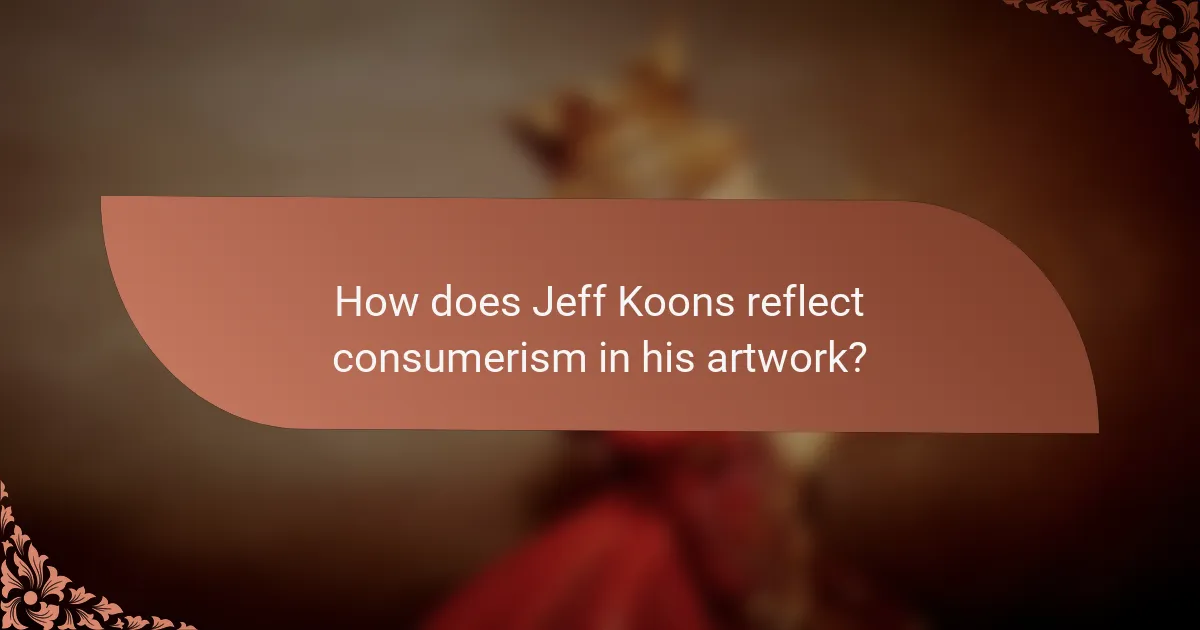
How does Jeff Koons reflect consumerism in his artwork?
Jeff Koons reflects consumerism in his artwork by transforming everyday objects into high art. His pieces, like “Balloon Animals,” challenge traditional notions of value and aesthetics. Koons uses shiny, mass-produced materials to evoke the allure of consumer goods. This approach critiques society’s obsession with materialism while simultaneously embracing it. His work invites viewers to reconsider the boundaries between art and commerce.
What are the key themes of consumer culture in Koons’ pieces?
Jeff Koons’ pieces critically explore themes of consumer culture through irony, nostalgia, and commercialization. His work reflects society’s obsession with materialism and the commodification of art. Koons employs familiar objects and pop culture references, making art accessible while challenging viewers to reconsider their consumption habits. The use of shiny surfaces and vibrant colors evokes a sense of attraction, mirroring advertising techniques. Ultimately, Koons’ art serves as a commentary on the intersection of art and consumerism, prompting reflection on value and authenticity in a consumer-driven world.
Which artworks exemplify the intersection of art and commerce?
Jeff Koons’ artworks exemplify the intersection of art and commerce through their vibrant engagement with consumerism and pop culture. His pieces, such as “Balloon Dog” and “Michael Jackson and Bubbles,” utilize commercial aesthetics to challenge and reflect societal values. Koons’ unique approach transforms everyday objects into high art, blurring the lines between luxury and mass production. His work often sells for record-breaking prices, illustrating how art can become a commodity while critiquing consumer culture.
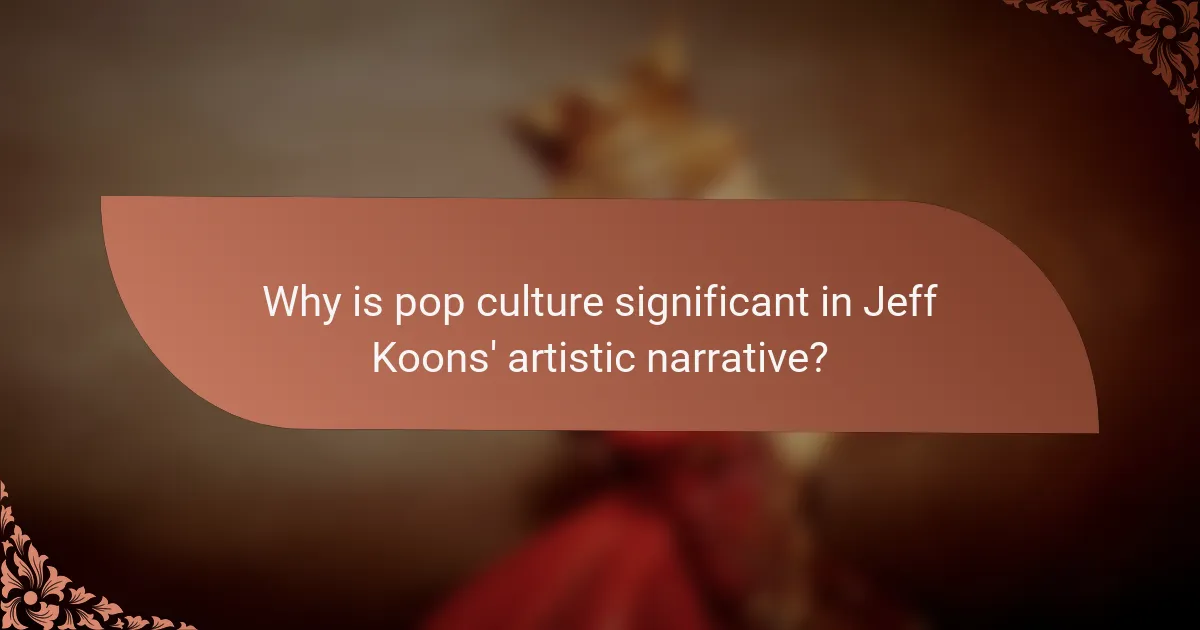
Why is pop culture significant in Jeff Koons’ artistic narrative?
Pop culture is significant in Jeff Koons’ artistic narrative as it critiques consumerism and reflects societal values. His work often incorporates everyday objects, transforming them into high art. This juxtaposition challenges traditional notions of art and elevates the mundane to the extraordinary. Koons’ use of familiar imagery resonates with audiences, making complex themes accessible. Through this lens, he explores the relationship between art, commerce, and popular culture, revealing underlying tensions in contemporary society.
How does Koons incorporate popular icons into his art?
Jeff Koons incorporates popular icons into his art by transforming everyday objects and imagery into high art. He uses recognizable symbols from consumer culture, such as toys and advertisements, to explore themes of desire and commodification. Koons’ unique approach elevates these icons, prompting viewers to reconsider their significance. His works, like the “Balloon Animals,” reflect a blend of innocence and commercialism, effectively engaging audiences with familiar references while challenging notions of value in art.
What role does nostalgia play in his work?
Nostalgia plays a significant role in Jeff Koons’ work by evoking emotional connections to consumerism and pop culture. His art often references childhood memories and iconic imagery, creating a sense of familiarity and comfort. This approach allows viewers to engage with complex themes through a lens of personal experience. Koons’ use of bright colors and playful forms enhances this nostalgic appeal, making his pieces both visually striking and emotionally resonant. By tapping into shared cultural memories, Koons critiques consumerism while simultaneously celebrating its allure.

What are the unique materials and techniques used by Jeff Koons?
Jeff Koons employs unique materials and techniques that challenge traditional art forms. He frequently uses stainless steel, which allows for reflective surfaces and vibrant colors. His signature approach includes employing industrial processes, such as balloon animal sculptures created through advanced manufacturing techniques. Additionally, he often collaborates with skilled artisans to achieve precise craftsmanship, enhancing the visual impact of his works. By merging high art with consumer culture, Koons creates pieces that provoke thought and discussion around materialism and aesthetics.
How do these choices differentiate his work from other contemporary artists?
Jeff Koons’ work uniquely critiques consumerism and pop culture, setting him apart from contemporary artists. His use of everyday objects as art challenges traditional definitions and elevates commercialism to high art. For example, his balloon animal sculptures transform familiar items into symbols of luxury and desire. This approach contrasts with artists who focus on personal or abstract expressions, emphasizing Koons’ role in merging art with commercial culture. His distinct style and thematic focus create a dialogue around the value of objects in society, highlighting the intersection of art and consumerism.
What impact do these materials have on the perception of his art?
The materials used in Jeff Koons’ art significantly shape the perception of consumerism and pop culture. His choice of materials, such as stainless steel and inflatable forms, emphasizes the commercial aspects of art. These materials reflect a unique attribute of his work, highlighting the intersection of high art and consumer goods. As a result, viewers often interpret his pieces as critiques of materialism, blurring the lines between art and commercialism. This duality enhances the overall impact and invites diverse interpretations among audiences.
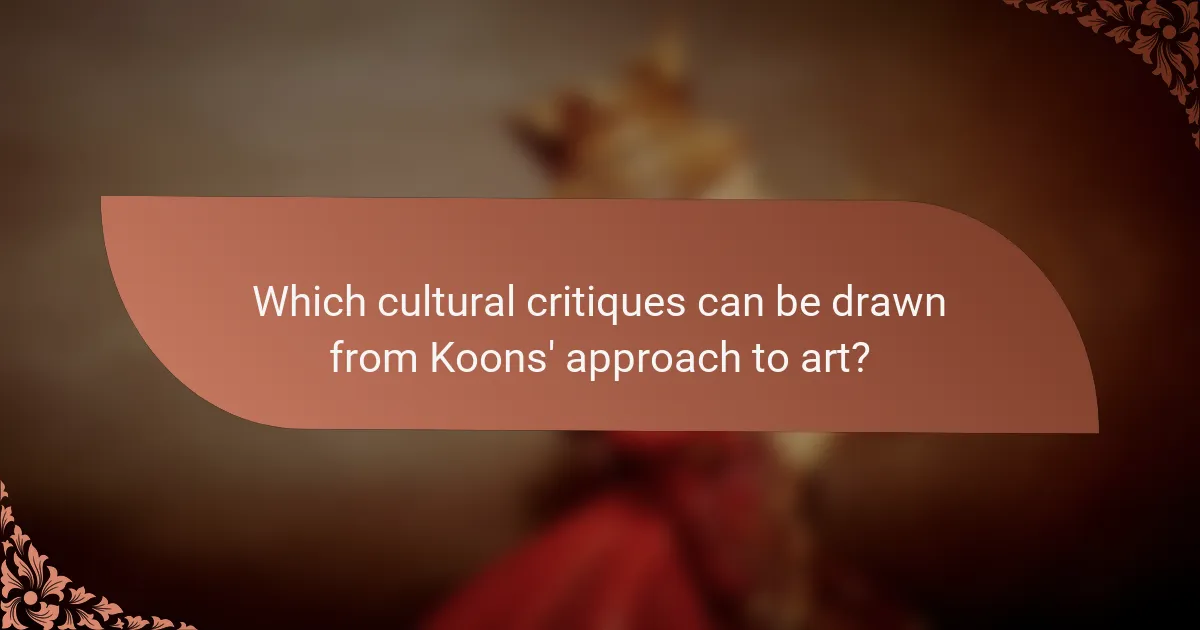
Which cultural critiques can be drawn from Koons’ approach to art?
Jeff Koons critiques consumerism and pop culture through his art by reflecting on superficiality and commodification. His work often incorporates everyday objects, challenging notions of value and authenticity. This approach highlights the tension between high art and commercial culture, prompting viewers to reconsider their perceptions of art’s purpose. Koons’ unique use of shiny materials and kitschy themes further emphasizes the allure of consumer goods, revealing the complexities of desire in contemporary society. Through these elements, he stimulates discussions about identity, materialism, and the role of art in a consumer-driven world.
How does he challenge traditional notions of value and authenticity?
Jeff Koons challenges traditional notions of value and authenticity by redefining art as a commercial product. He blurs the lines between high art and consumer culture, emphasizing mass production and branding. This approach provokes questions about the nature of artistic value in a commodified world. Koons’ use of everyday objects as art reveals a unique attribute: he elevates the banal to the extraordinary, questioning what constitutes genuine artistic expression.
What reactions have his works elicited from critics and audiences alike?
Jeff Koons’ works have sparked diverse reactions from critics and audiences. Critics often highlight his provocative approach to consumerism and pop culture, praising his ability to challenge traditional art norms. Audiences frequently respond with fascination and intrigue, drawn to the vibrant aesthetics and playful themes of his pieces. Some view his art as a reflection of contemporary society’s obsession with materialism, while others criticize it as superficial or lacking depth. Overall, his work elicits a mix of admiration and debate, underscoring its impact on modern art discourse.
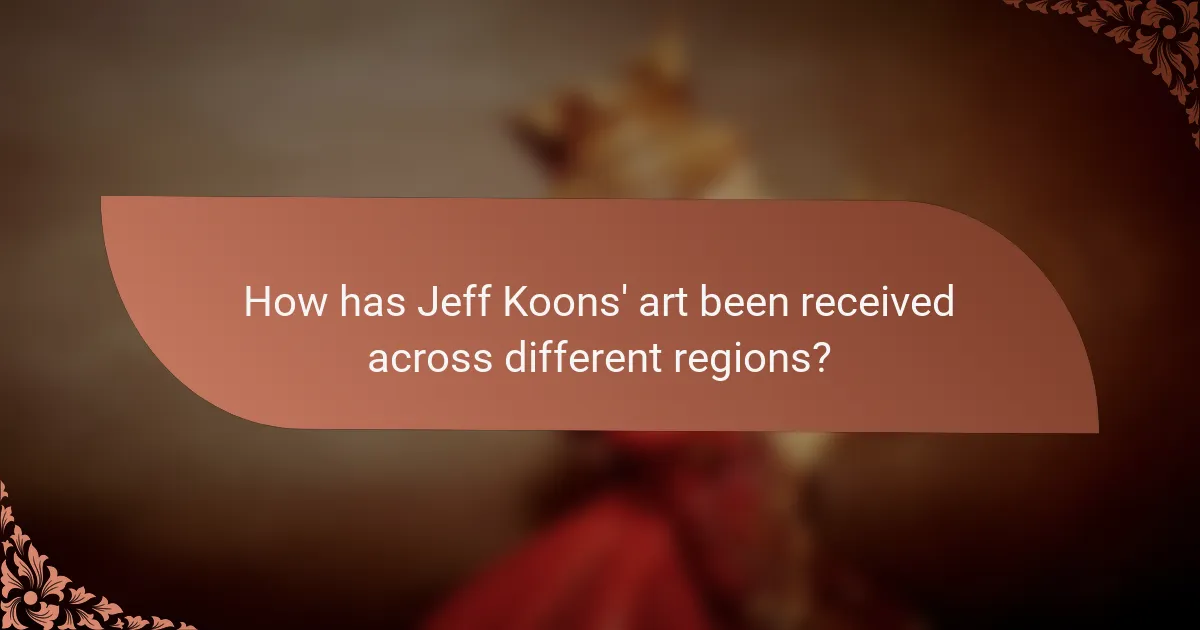
How has Jeff Koons’ art been received across different regions?
Jeff Koons’ art has received varied reception across different regions, reflecting diverse cultural perspectives. In the United States, his work often sparks debate on consumerism and kitsch, while in Europe, it is frequently celebrated for its bold commentary on art and society. In Asia, particularly in China, Koons’ pieces have gained popularity due to their vibrant aesthetics and connection to contemporary culture. Additionally, collectors in regions like the Middle East show growing interest, viewing his art as a symbol of luxury and status.
What are the notable differences in interpretation between North America and Europe?
The notable differences in interpretation between North America and Europe regarding Jeff Koons’ work stem from cultural context and consumerism perspectives. North American audiences often view his art as a critique of consumer culture, emphasizing its commercial aspects. In contrast, European interpretations tend to focus on the philosophical implications of consumerism and its impact on identity and society. This divergence highlights the unique attributes of each region’s art appreciation, shaped by historical and social factors.
How do cultural values influence the reception of his work in various markets?
Cultural values significantly shape the reception of Jeff Koons’ work across different markets. In Western cultures, his bold consumerism and pop culture themes resonate with a fascination for materialism. In contrast, Eastern cultures may interpret his work through a lens of tradition and restraint, leading to mixed reactions. The unique attribute of his art lies in its ability to provoke dialogue about societal norms. As a result, Koons’ work can be polarizing, reflecting the diverse values and beliefs of various audiences.
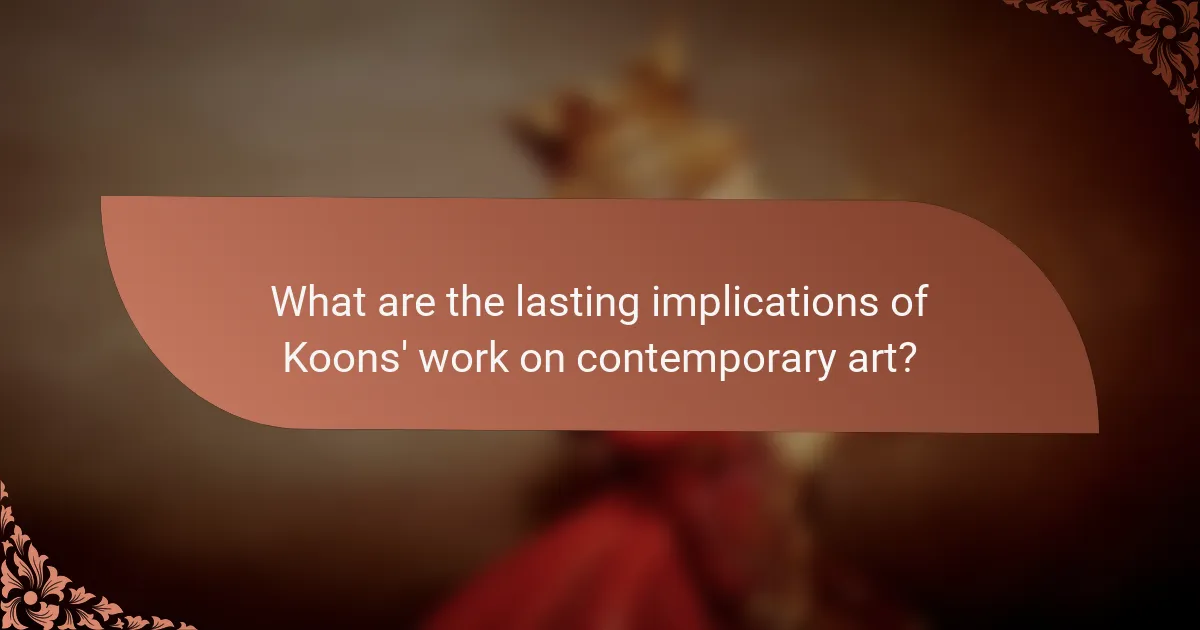
What are the lasting implications of Koons’ work on contemporary art?
Jeff Koons’ work has profoundly influenced contemporary art by challenging perceptions of consumerism and pop culture. His approach has encouraged artists to explore commercialism, blurring the lines between high art and mass production. As a result, Koons’ impact is evident in the rise of art that embraces popular culture, reflecting societal values and consumer behavior. This shift has led to a broader acceptance of diverse artistic expressions and has redefined the role of the artist in a market-driven society. Furthermore, his emphasis on kitsch has sparked discussions about authenticity and value in art, prompting both admiration and criticism in the contemporary art landscape.
How has he influenced other artists in the realm of consumerism and pop culture?
Jeff Koons has significantly influenced other artists by redefining consumerism in art. His bold use of commercial imagery challenges traditional boundaries, inspiring a new generation to explore the intersection of art and consumer culture. Koons’ work emphasizes the value of mass production and consumer goods, encouraging artists to embrace commercial aesthetics. This shift has led to a broader acceptance of pop culture elements in contemporary art, as seen in the works of artists like Takashi Murakami and Damien Hirst. Their creations reflect Koons’ impact, merging high art with consumerism and expanding the definition of artistic expression.
What lessons can be learned from his approach to art and commerce?
Jeff Koons teaches that art can be a powerful commentary on consumerism and pop culture. His approach blends commercial techniques with artistic expression, emphasizing the value of accessibility in art. By using familiar imagery and objects, he engages a broad audience, highlighting the intersection of art and everyday life. This strategy shows that art can reflect societal values while also serving as a lucrative business model. Koons’ work exemplifies how artists can thrive commercially while challenging cultural norms and perceptions.
What best practices can artists adopt from Jeff Koons’ strategies?
Artists can adopt several best practices from Jeff Koons’ strategies to enhance their engagement with consumerism and pop culture. First, they should embrace bold visual aesthetics that capture attention and provoke thought. Second, leveraging popular culture references can create relatable and accessible art. Third, utilizing high-quality materials and craftsmanship can elevate the perceived value of their work. Fourth, artists should consider the commercialization of their art without compromising their vision, striking a balance between art and marketability. Lastly, engaging with a broad audience through social media can amplify reach and foster community interaction.
